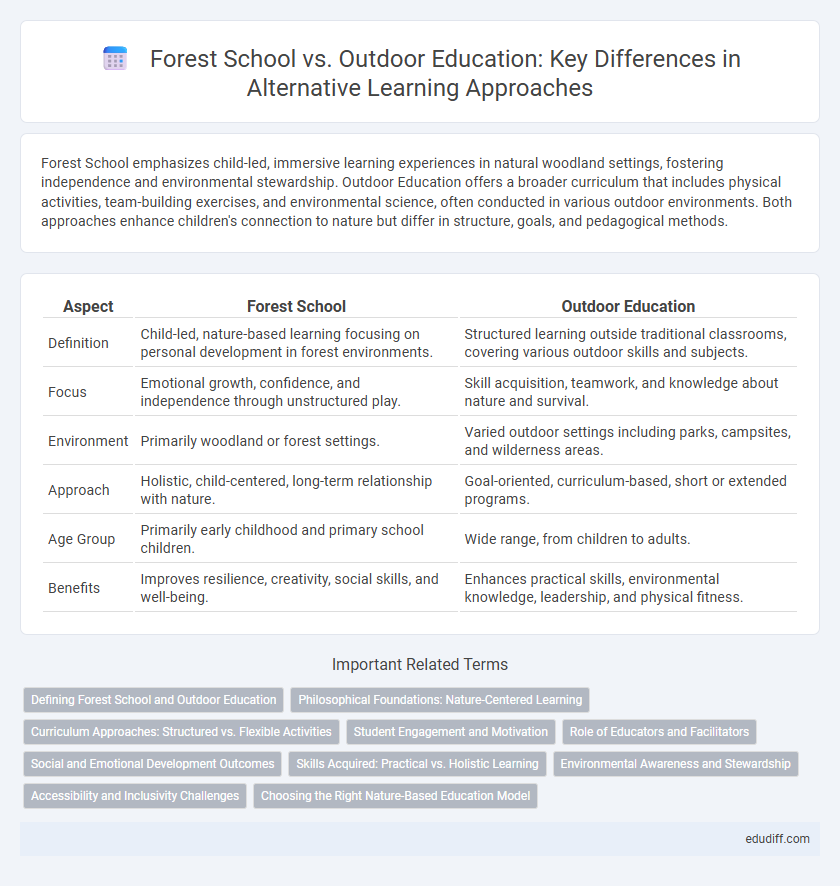Forest School emphasizes child-led, immersive learning experiences in natural woodland settings, fostering independence and environmental stewardship. Outdoor Education offers a broader curriculum that includes physical activities, team-building exercises, and environmental science, often conducted in various outdoor environments. Both approaches enhance children's connection to nature but differ in structure, goals, and pedagogical methods.
Table of Comparison
| Aspect | Forest School | Outdoor Education |
|---|---|---|
| Definition | Child-led, nature-based learning focusing on personal development in forest environments. | Structured learning outside traditional classrooms, covering various outdoor skills and subjects. |
| Focus | Emotional growth, confidence, and independence through unstructured play. | Skill acquisition, teamwork, and knowledge about nature and survival. |
| Environment | Primarily woodland or forest settings. | Varied outdoor settings including parks, campsites, and wilderness areas. |
| Approach | Holistic, child-centered, long-term relationship with nature. | Goal-oriented, curriculum-based, short or extended programs. |
| Age Group | Primarily early childhood and primary school children. | Wide range, from children to adults. |
| Benefits | Improves resilience, creativity, social skills, and well-being. | Enhances practical skills, environmental knowledge, leadership, and physical fitness. |
Defining Forest School and Outdoor Education
Forest School is a learner-centered educational approach emphasizing regular, hands-on experiences in natural woodland environments to foster independence, resilience, and environmental awareness. Outdoor Education encompasses a broader spectrum of activities beyond forests, including fields, mountains, and aquatic settings, aimed at developing physical skills, teamwork, and ecological knowledge through experiential learning. Both prioritize active engagement with nature but differ in scope and pedagogical focus, with Forest School rooted in long-term personal development and Outdoor Education targeting diverse outdoor skills and environmental understanding.
Philosophical Foundations: Nature-Centered Learning
Forest School and Outdoor Education both emphasize nature-centered learning, but Forest School prioritizes child-led exploration fostering autonomy and deep emotional connections with the environment. Outdoor Education often integrates structured curriculum goals targeting ecological knowledge and outdoor skills development. The philosophical foundation of Forest School roots in constructivist theories, promoting holistic growth through immersive natural experiences.
Curriculum Approaches: Structured vs. Flexible Activities
Forest School emphasizes flexible activities that encourage child-led exploration and experiential learning, fostering creativity and resilience in natural settings. Outdoor Education typically follows a structured curriculum with defined outcomes, integrating physical skills development and environmental knowledge. Both approaches promote outdoor engagement but differ in pedagogical frameworks and adaptability to individual learner needs.
Student Engagement and Motivation
Forest School emphasizes child-led learning through direct interaction with natural environments, fostering intrinsic motivation and deep student engagement by encouraging autonomy and creativity. Outdoor Education combines structured curriculum goals with experiential activities, promoting engagement by linking real-world contexts to academic content. Both approaches enhance motivation but Forest School uniquely nurtures sustained enthusiasm through immersive, play-based experiences.
Role of Educators and Facilitators
Educators in Forest School act as guides who foster child-led exploration, emphasizing emotional development and social skills through nature-based activities. In Outdoor Education, facilitators deliver structured learning objectives aligned with academic or physical goals, prioritizing skill acquisition and environmental knowledge. Both roles require adaptability and expertise to create safe, engaging experiences that connect learners deeply with the natural environment.
Social and Emotional Development Outcomes
Forest School programs emphasize child-led exploration in natural settings, fostering social skills such as cooperation, empathy, and conflict resolution through unstructured, peer-based activities. Outdoor Education typically incorporates structured learning objectives with physical challenges that enhance teamwork, communication, and resilience. Studies show Forest School participants demonstrate significant improvements in emotional regulation and self-confidence compared to traditional Outdoor Education methods.
Skills Acquired: Practical vs. Holistic Learning
Forest School emphasizes practical skills such as tool use, fire building, and ecological awareness, fostering hands-on learning directly within natural environments. Outdoor Education provides a more holistic approach, integrating physical, emotional, and social development through diverse activities like team challenges, environmental science, and leadership exercises. Both methods cultivate essential life skills, but Forest School concentrates on experiential mastery while Outdoor Education promotes broad personal growth.
Environmental Awareness and Stewardship
Forest School programs immerse children in natural woodland environments, fostering deep environmental awareness through hands-on, experiential learning that promotes ecological stewardship. Outdoor Education often includes broader outdoor settings and structured activities designed to develop environmental knowledge alongside physical skills, encouraging responsible attitudes toward nature conservation. Both approaches enhance students' connection to the environment, but Forest School uniquely emphasizes long-term relationship building and sustainable practices within forest ecosystems.
Accessibility and Inclusivity Challenges
Forest School programs often face accessibility challenges due to location, transportation, and physical terrain that can limit participation for children with disabilities or those from urban areas. Outdoor Education initiatives, while more varied in setting, similarly struggle with inclusivity when resources, specialized equipment, or trained staff are lacking to support diverse needs. Both approaches require targeted strategies to overcome socioeconomic and physical barriers to ensure equitable access for all learners.
Choosing the Right Nature-Based Education Model
Forest School emphasizes child-led, experiential learning in a woodland setting, fostering independence and resilience through long-term engagement with nature. Outdoor Education offers a broader curriculum that includes skills like survival techniques, environmental science, and teamwork in diverse outdoor environments. Selecting the right nature-based education model depends on the child's learning style, developmental needs, and the program's alignment with educational goals such as emotional growth or practical skill acquisition.
Forest School vs Outdoor Education Infographic

 edudiff.com
edudiff.com